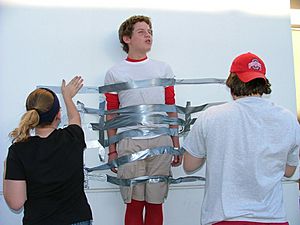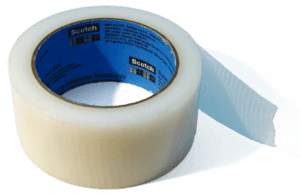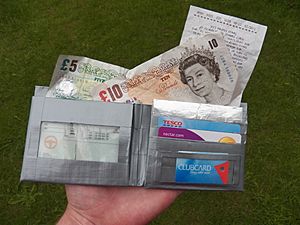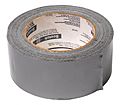Duct tape facts for kids

Duct tape, sometimes called duck tape, is a super strong adhesive tape. It has a special cloth backing that makes it tough. Usually, you'll see it in grey or black, but it comes in many other colors too! People use duct tape to fix all sorts of things, like a broken handbag or a wobbly chair. It's known for being very sticky and useful for quick repairs.
Duct tape was first made during World War I. It was created to keep water out of ammunition cases. It worked so well that people quickly found many other uses for it. Soldiers even called it "100 mph tape" because it was said to stick even in very strong winds. The name "duct tape" came from its use on heating and air conditioning ducts. But actually, it's not the best tape for those ducts! In some places like California, it's even illegal to use regular duct tape on them.
In the United States, duct tape is often seen in movies and TV shows. Because it's so strong, strips of it can be used to tie people up, making it very hard to escape.
Duct tape is also fantastic for making cool things. People create wallets, purses, clothes, and even sculptures with it. Using duct tape for art is a fairly new and creative idea.
Contents
How Duct Tape Started
The idea for modern duct tape came from a clever woman named Vesta Stoudt. She worked in a factory during World War II, making ammunition. She worried that the boxes weren't sealed well enough, which could waste precious time for soldiers in battle. In 1943, she wrote to President Franklin D. Roosevelt with her idea: seal the boxes with a strong fabric tape. She had even tested it herself!
Her letter was sent to the War Production Board. They asked Johnson & Johnson to create this new tape. A team there developed a special adhesive tape that could be torn by hand, not needing scissors.
This new tape was made from thin cotton cloth, covered in waterproof plastic (polyethylene), and had a strong rubber-based grey adhesive. It was easy to put on and take off. Soon, soldiers used it to quickly fix military equipment, like vehicles and weapons. This tape was colored a dull green, like army uniforms, and soldiers nicknamed it "duck tape." There are a few ideas why they called it that, like its connection to "cotton duck" fabric, or how it was waterproof like a duck bird.
After the war, this "duck tape" was sold in hardware stores for home repairs. In the 1950s, it became popular for wrapping air ducts in buildings. Because of this, people started calling it "duct tape." It was often made in a silvery-grey color, just like the metal ducts.
Later, in 1975, a company called Manco rebranded their duct tape. They trademarked the name "Duck Tape" and used a fun yellow cartoon duck logo. This helped "Duck Tape" become super popular, and it's still a well-known brand today.
How Duct Tape is Made
Modern duct tape is made with a woven fabric to give it strength. This fabric can be made from cotton, polyester, nylon, or even fiberglass. This thin fabric, called "scrim," is then covered with a layer of plastic. The common grey color comes from tiny bits of aluminum mixed into the plastic.
Cool Ways People Use Duct Tape
Duct tape is used in many situations where you need a strong, flexible, and very sticky tape. Some types are made to last a long time and stand up to different weather conditions.
- Gaffer Tape: There's a special kind of tape called "gaffer tape" that looks like duct tape. But gaffer tape doesn't leave a sticky mess when you remove it. This is why people who work in theater, movies, and TV shows love it.
- Motorsports: In car racing, duct tape is sometimes called "racer's tape" or "100 mile an hour tape." Racers have used it for over 40 years to quickly fix parts of their cars, like fiberglass bodywork. It comes in many colors to match different car paints.
Not for Air Ducts?
Even though it's called "duct tape," the common kind isn't actually the best for sealing heating and air conditioning (HVAC) ducts. Studies have shown that regular duct tape can become brittle and fail quickly when used on ducts, leading to leaks. Special tapes are made just for sealing ducts, and they work much better. In some places, building rules even say you can't use regular duct tape on ducts because it might not be safe or last long enough.
Duct Tape in Space!
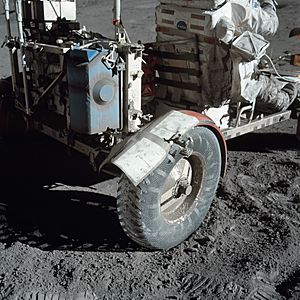
Did you know duct tape has been to space? NASA engineers and astronauts have used it in their work, even in emergencies!
One famous example happened in 1970 during the Apollo 13 mission. An explosion damaged the spacecraft, and the astronauts had to use the lunar module as a lifeboat. But the square carbon dioxide filters from the main ship didn't fit the round openings in the lunar module. NASA engineers on Earth quickly figured out a way to make them fit using duct tape and other items the astronauts had. They gave instructions to the crew, and the filters started working again, saving the lives of the three astronauts!
Another time, during the Apollo 17 mission, astronauts on the moon used duct tape to fix a damaged fender on their lunar rover. This kept lunar dust from spraying everywhere as they drove.
Military Uses
In the US submarine fleet, a strong cloth tape is sometimes called "EB Green" because the tape used by Electric Boat was green. It's also known as "duck tape," "riggers' tape," or "100-mph tape." This name comes from its use during the Vietnam War to repair or balance helicopter rotor blades.
Fun and Creative Uses
Duct tape is so popular and useful that it's become a big part of pop culture. People come up with all sorts of creative and imaginative ways to use it!
- Wart Treatment: Some people have tried using duct tape to treat warts by covering them for a long time. While some studies suggest it might help, it's not a standard medical treatment.
- iPhone Fix: Believe it or not, duct tape was even used to temporarily fix a problem with the iPhone 4's antenna, helping with dropped calls!
Duct Tape in Pop Culture
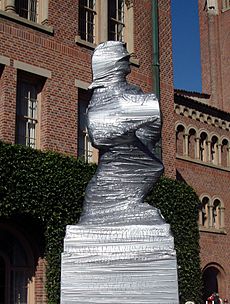
- The Duct Tape Guys: Jim Berg and Tim Nyberg, known as "The Duct Tape Guys," have written many books about duct tape. They've sold over 1.5 million copies! They even made up the famous saying, "it ain't broke, it just lacks duct tape." Their website shows thousands of amazing duct tape creations from people all over the world, from clothes to car repairs.
- The Red Green Show: In the Canadian TV show The Red Green Show, the main character, Red Green, often used duct tape (which he called "the handyman's secret weapon") for all sorts of unusual fixes. The show even had a movie called Duct Tape Forever.
- MythBusters: The TV show MythBusters often used duct tape to test crazy ideas. They've used it to hang a car, build a working cannon, make a sailboat, a canoe, and even a bridge! In one episode, they even repaired (and later replaced) the skin of a lightweight airplane with duct tape and flew it!
Duct Tape Alert
In 2003, the U.S. Department of Homeland Security suggested that Americans should get ready for possible emergencies. They recommended putting together a "disaster supply kit" that included items like duct tape and plastic sheeting. The idea was that people could try to seal their homes against certain dangers.
This recommendation caused a huge demand for duct tape in stores. It also became a funny topic for comedians and satirists, who joked about "duct and cover," a play on the old "duck and cover" drills.
Images for kids
See also
 In Spanish: Cinta americana para niños
In Spanish: Cinta americana para niños


